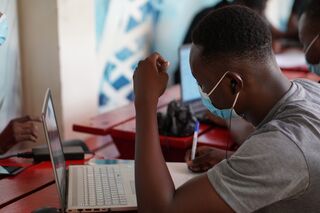Career
Considering COVID-19, Return to Work, and PTSD
A case for trauma-informed policy.
Posted August 17, 2021 Reviewed by Jessica Schrader
Key points
- For educators, the start of the fall semester amid the ongoing pandemic can bring feelings of angst for a variety of reasons.
- Trauma-informed responses and policies are needed in any return-to-work plan, especially in fields like therapy and education.
- Educators and healers can benefit from institutional policies that are compassionate to the lived realities of trauma and its aftermath.
Recently, I had a phone conversation with one of my dear friends who is a psychoanalyst. The conversation turned to decisions that he and his colleagues are in the process of making related to teaching and training amidst COVID. He explained that he believes they all should go back in person. But the most interesting part of his comment came next when he observed that opposition to this doesn’t appear to be scientifically viable. With great conviction, he stated, “An emotional response is not enough.”
I was floored.
I thought to myself, "Who snatched my compassionate and brilliant friend?"
All I could muster was, “Wow, really?!” He seemed equally surprised by my question and asked why I said that. “Well, I mean, given your profession, I would think an emotional response would matter more,” I replied.
I didn’t share with him the rest of what was going through my mind. I love him and am sure I could. But, in the moment, the cleavages brought on by the pandemic felt too deep, and I felt far too vulnerable to coherently respond in that moment. I chalked it up to the fact that I’m in South Carolina and he is in New York, so context matters. Vaccination rates and mandates are very different, and attitudes about mitigation strategies are even more different still.

I’ve been riddled with anxiety for weeks, not just about navigating daily life amidst this health and sociopolitical crisis but also because of the return to school happening now. Like many states, South Carolina has an abysmal vaccination rate, an even worse one for the college-age group I teach, and few restrictions. For 26 years of teaching, I would always joke that it’s like living in a petri dish, but this takes on new meaning now.
It makes some sense that my usually like-minded friend and I weren’t seeing eye to eye on this issue because of the perverse and grotesque variability that exists across state lines. Social context and social forces have shaped our responses, at once enabling my friend’s behavioral options while simultaneously constraining mine.
I have been trying to understand why thinking and talking about the fall semester gives me such profound angst. Is it as simple and straightforward as I’m afraid of getting sick, or worse, being hospitalized and possibly dying as has happened to too many people? Sure, that’s of concern. But, I have come to see that it’s deeper and more complicated than that.
See, during my childhood and young adult years, I witnessed and experienced domestic violence and later went on to work as a counselor and clinical supervisor in abuse intervention programs, working with abusers and victims of violence. My personal and professional experiences shed light on the myriad ways that people caught in this web of fear and entrapment feign normalcy for the outside world. Shame, minimization, rationalization, and denial swirl together with often empty apologies and promises. It’s isolating. It’s also fragmenting and splintering to one’s sense of self.
You want to run. You want refuge. You want someone to see and hear for themselves what you are seeing and hearing. You assume that if someone could, they would help and you suddenly could stop living like that, walking on eggshells and fearing what’s next. You see other kids and wives and families and friends going about their lives with greater ease and moving around more freely. You wonder why you can’t have that. You wonder what you did wrong. You wonder how you might ever see things change, how you might disrupt the silence of compliance to violence.
This brings me back to my response to in-person teaching during record highs of the pandemic. The system administration’s message is that all must be—and will be—back to normal (whatever that even means anymore) and that students need to see everything as it would have been up through fall 2019.
A state that demands its public schools and universities to comply with what are essentially arbitrary guidelines (since other states have different mandates that promote better health) and then forces employees to acquiesce to fake normalcy is akin to what victims of violence are asked to do every day. Whereas adult perpetrators and victims of family violence consciously and unconsciously enlist children in sustaining fake normalcy and an outrageous sense of hypocrisy, educators are asked to engage students in this same enterprise.
I’ve spent over half of my lifetime living like that and the other half working to undo the damage of that way of thinking and being. Who would ever be OK with going back?
When I see other universities with plans that are the exact opposite of the system I am part of, including mandatory vaccinations for all students and employees on campus, masking, distancing, routine testing, and dropping and fining registered students if they have not gotten vaccinated, I am happy for them and validated in seeing that there are others choosing to do the right thing. And, I immediately feel very angry and sad. It’s like looking at a really normal, happy family with parents who are deeply in love and warm and affectionate with each other. It’s something I want deep in my bones and yet it’s something I can’t have. Something I’ll never get to know.
I’m reminded of what my friend said about how an emotional response to returning to business as usual at a workplace is not enough and that such a response cannot inform policy, and again I am left wondering, why not? It might be arguably what is necessary.
We need trauma-informed responses and policies in any return-to-work plan, and maybe most in professions like his and mine—therapy and education. Rachel Naomi Remen states: “Educare, the root of the word education, means ‘to lead forth the hidden wholeness,’ the innate integrity that is in every person. And as such, there is a place where ‘to educate’ and ‘to heal’ mean the same thing. Educators are healers.”
Educators and healers have a greater capacity to cultivate wholeness and integrity in others when they are able to touch and feel it in themselves, unencumbered by fear and where self-preservation is not all-consuming.
Educators like me who try to show up wholehearted, refuse to sugarcoat reality, and work to nurture those qualities in others benefit from institutional policies that are compassionate to the lived realities of trauma and its aftermath. That should be available to all of us, regardless of what state we inhabit. It’s a wholeness in body and mind that shouldn’t elude some of us.
References
Remen, Rachel Naomi. (1999). “Educating for Mission, Meaning and Compassion” in edited volume, The Heart of Learning: Spirituality in Education edited by Steven Glazer, Tarcher/Putnam New York. Pg. 35.




